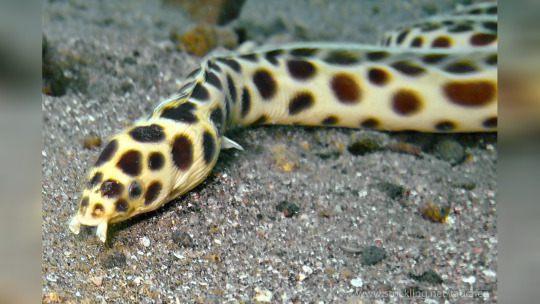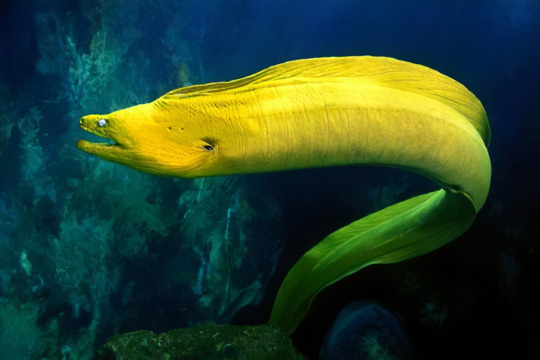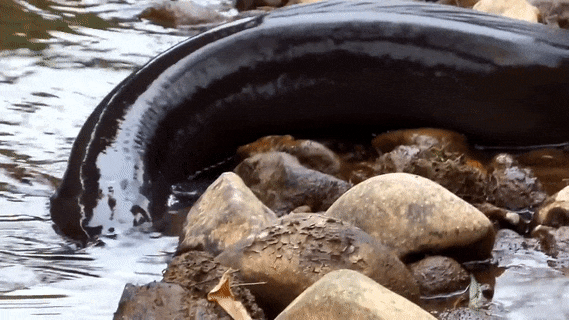#longfin eel
Explore tagged Tumblr posts
Text




@fishyfishyfishtimes
206 notes
·
View notes
Text
#2582 - Aguilla dieffenbachii - New Zealand Longfin Eel



AKA ōrea.
Aotearoa's only endemic freshwater eel (the other two are variously also found in Australia, or introduced from Australia) and the largest. Females can be over a meter and a half long.
A very important food for the Māori, but now numbers have seriously declined and the species is considered endangered. One reason is that they only mate once, and they take 20 to 60 years to reach adulthood. When they do, they leave freshwater and head far out to sea to the ocean near Tonga, breed, and die. Only a handful of the 1 to 10 million eggs each female lays will survive to repeat the process.
If they can't find a way back to the sea (rare, since they can cross open ground if they have to) the females reabsorb their eggs and can live past a century. The ones in the tank at the Hotitika National Kiwi Centre used to live in a pond behind a canning plant where food was abundant and life carefree.
The returning young are pretty agile too, as their swim upstream - elvers have been seen climbing near vertical surfaces over 40m high.
The eels are omnivorous and opportunistic feeders - you may have seen the video where they descend on a pizza like elongated pirahna.
Hokitika, Aotearoa New Zealand.
18 notes
·
View notes
Text
When I hear about the hydra’s toxic blood I’m like “cool, mythology!” but then I learn that three tablespoons of longfin eel blood can kill someone
#guess who just watched river monsters lol#when you experience the world enough you learn that myths are real <333#greek mythology#longfin eel#fish
7 notes
·
View notes
Text
Daily fish fact #406
New Zealand longfin eel!

It is one of three freshwater eels found in New Zealand, distinguished from the rest by its dorsal fin that extends noticeably longer than the anal fin (hence the name)! It is very long lived, some individuals living to be over 100.
#it can also be called tuna! in case you were wondering why that tag is featured.#fish#fishfact#fish facts#fishblr#biology#zoology#eel#eels#new zealand longfin eel#tuna#longfin eel
221 notes
·
View notes
Text
@fishpostings
IMPORTANT QUESTION.
Favourite kind of fish? Favourite species of fish?
Mine are eels, specifically spotted snake eels (they're very pretty) and gulper eels (they're really interesting) and green moray eels (i've seen some in the wild) with honorary mentions to nz longfin eels (i've seen many in the wild because they are everywhere, also they are some really cool fish), how about yours?




Also what are your opinions on crabs?
#fish#gulper eel#deep sea creatures#eels#spotted snake eel#garlic breath#green moray eel#moray eel#nz longfin eel#longfin eel
60 notes
·
View notes
Text
a peaceful moment with a very large and beautiful tuna kūwharuwharu (longfin eel, Anguilla dieffenbachii) <3
38 notes
·
View notes
Text

3 notes
·
View notes
Photo
New Zealander here: what the fuck is that thing


New Zealand Longfin Eel
(source)
106K notes
·
View notes
Text
Uncharismatic Fact of the Day
In Aotearoa, it's whitebait season, and that means eels, eels, and more eels! Perhaps the most famous is the longfin eel, which is one of the longest eels in the world and is only found in New Zealand. During its migration, juvenile eels, aka elvers, make a perilous journey from the ocean through inland rivers, sometimes climbing up 20 m (65 ft) waterfalls to reach the lakes where they will spend the majority of their lives.

(Image: A longfin eels, aka tuna kuwharuwharu (Anguilla dieffenbachii) by Sean Clifford)
#new zealand longfin eel#orea eel#Anguilliformes#Anguillidae#freshwater eels#eels#ray-finned fish#fish#uncharismatic facts
68 notes
·
View notes
Text
Because tuatara are very long lived - between 100 and 200 years by most estimates […] - the founding of Aotearoa/New Zealand as a modern nation and the unfolding of settler-wrought changes to its environment have transpired over the course of the lives of perhaps just two tuatara [...].
---
[T]he tuatara (Sphenodon punctatus) [...] [is] the sole surviving representative of an order of reptiles that pre-dates the dinosaurs. [...] [T]he tuatara is of immense global and local significance and its story is pre-eminently one of deep timescales, of life-in-place [...]. Epithets abound for the unique and ancient biodiversity found in Aotearoa/New Zealand. Prized as “Ghosts of Gondwana” (Gibbs 2008), or as denizens of “Moa’s Ark” (Bellamy et al. 1990) or “The Southern Ark” (Andrews 1986), the country’s faunal species invoke fascination and inspire strong language [...]. In rounded terms, it [has been] [...] just 250 years since James Cook made landfall; just 200 years since the founding of the handful of [...] settlements that instigated agricultural transformation of the land [...]. European newcomers [...] were disconcerted by the biota [...]: the country was seen to “lack” terrestrial mammals; many of its birds were flightless and/or songless; its bats crawled through leaf-litter; its penguins inhabited forests; its parrots were mountain-dwellers; its frogs laid eggs that hatched miniature frogs rather than tadpoles [...].
---
Despite having met a reassuringly temperate climate [mild, oceanic, comparable to western Europe], too, the newcomers nevertheless sought to make adjustments to that climate, and it was clear to them that profits beckoned. Surveying the towering lowland forests from the deck of HMS Endeavour in 1769, and perceiving scope for expansion of the fenland drainage schemes being undertaken at that time in England and across swathes of Europe, Joseph Banks [botanist on Cook's voyage] reported on “swamps which might doubtless Easily be drained” [...]. Almost a century later, in New Zealand or Zealandia, the Britain of the South, [...] Hursthouse offered a fuller explication of this ethos: The cultivation of a new country materially improves its climate. Damp and dripping forests, exhaling pestilent vapours from rank and rotten vegetation, fall before the axe [...]. Fen and march and swamp, the bittern’s dank domain, fertile only in miasma, are drained; and the plough converts them into wholesome plains of fruit, and grain, and grass. [...]
[The British administrators] duly set about felling the ancient forests of Aotearoa/New Zealand, draining the country’s swamps [...]. They also began importing and acclimatising a vast array of exotic (predominantly northern-world) species [sheep, cattle, rodents, weasels, cats, crops, English pasture grasses, etc.] [...]. [T]hey constructed the seemingly ordinary agronomic patchwork of Aotearoa/New Zealand's productive, workaday landscapes [...]. This is effected through and/or accompanied by drastic deforestation, alteration of the water table and the flow of waterways, displacement and decline of endemic species, re-organisation of predation chains and pollination sequences and so on [...]. Aotearoa/New Zealand was founded in and through climate crisis [...]. Climate crisis is not a disastrous event waiting to happen in the future in this part of the world; rather, it has been with us for two centuries already [...].
---
[T]he crest formed by the twinned themes of absence and exceptionalism [...] has shaped this creature's niche in the western imagination. As one of the very oldest species on earth, tuatara have come to be recognised [in Euro-American scientific schemas] [...] as an evolutionary and biodiversity treasure [...]. In 1867, [...] Gunther [...] pronounced that it was not a lizard at all [...] [and] placed the tuatara [...] in a new order, Rhynchocephalia, [...] igniting a frenzy of scientific interest worldwide. Specifically, the tuatara was seen to afford opportunities for "astonished witnessing" [...], for "the excitement of having the chance to see, to study, to observe a true saurian of Mesozoic times in the flesh, still living, but only on this tiny speck of the earth [...], while all its ancestors [...] died about one hundred and thirty-five million years ago" [...]. Tuatara have, however, long held special status as a taonga or treasured species in Māori epistemologies, featuring in a range of [...] stories where [...] [they] are described by different climates and archaeologies of knowledge [...] (see Waitangi Tribunal 2011, p. 134). [...]
While unconfirmed sightings in the Wellington district were reported in the nineteenth century, tuatara currently survive only in actively managed - that is, monitored and pest-controlled - areas on scattered offshore islands, as well as in mainland zoo and sanctuary populations. As this confinement suggests, tuatara are functionally “extinct” in almost all of their former wild ranges. [...] [Italicized text in the heading of this post originally situated here in Boswell's article.] [...] In the remaining areas of Aotearoa/New Zealand where this species does now live [...], tuatara may in some cases be the oldest living inhabitants. Yet [...] if the tuatara is a creature of long memory, this memory is at risk of elimination or erasure. [...] [T]uatara expose and complicate the [...] machineries of public memory [...] and attendant environmental ideologies and management paradigms [...].
---
All text above by: Anna Boswell. "Climates of Change: A Tuatara's-Eye View". Humanities, 2020, Volume 9, Issue 2, 38. Published 1 May 2020. This article belongs to the Special Issue Environmental Humanities Approaches to Climate Change. [Bold emphasis and some paragraph breaks/contractions added by me. Text within brackets added by me for clarity. The first paragraph/heading in this post, with text in italics, are also the words of Boswell from this same article. Presented here for commentary, teaching, criticism purposes.]
#i posted commentary about this article in 2020 right after it was first published but i did a sloppy job presenting and discussing it#some might be familiar with boswells 2015 article on longfin eels or her article the stoat free state on weasels in aotearoa#basically she writes on british imperial environmental imaginaries#how settlement tries to reshape a colonys landscape in idealized english image of domesticated home replacing native species with introduce#ecology#abolition#imperial#colonial#landscape#paleo#aotearoa#indigenous#multispecies#black methodologies#indigenous pedagogies
76 notes
·
View notes
Text






I went for a hike and found some wet puppies. Very cute but keep your dogs on a leash ffs
24 notes
·
View notes
Note
when an eel bites your pie in a big eel pile thats a longfin
T̴̨͕̘̱̜̥̩̘͌͜ŗ̵̧̨̙̲͚̭̿̊į̸̖̳͓̖̬̃̈̔͋̀͗̏̉̾c̵̰̩͓̙̩͇̦̐͗̀͛̔́̑̚k̶̡̡͔͍͈̻̲̘̄͐̐͌̔̈́̂̓͒̌͜ ̵̢̖̩̤̘̠̗͆̀̽̄͝͠ǫ̸̧̤͔̙͕͎̤͐̊̋r̸̛̤͛̚͘̕ ̶̝͔̣̘̣̣̐͌̃͠͠t̷̢͉͙̪̘̺̒͜ŗ̶̣̘͈͖̫̫̺̮͈̉͑̔̈̐̂͐̄͌̚e̴͇͗̐̈́̄̒̌̆a̶̠͕͔̅̒̔̚t̵̢̢̡̡̘͙̯̹̙̻̂
Gesundheit! You get:

New Zealand Longfin Eels Enjoying A Pizza!
309 notes
·
View notes
Text
0 notes
Text

Les poissons 👍
#art#my art#digital art#art practice#wildlife art#fish#fishblr#new zealand longfin eel#anguilla dieffenbachii#koi#cyprinus carpio#rainbow trout#oncorhynchus mykiss#queue
103 notes
·
View notes
Text
Daily fish fact #788
New Zealand longfin eel!

Historically these eels could grow up to two meters long (6 feet 7 inches), but due to population decline the current average is 60 cm (2 feet) for males and one meter (3 feet) for females. Young eels migrate from the sea to freshwater, and will often climb waterfalls and even dams on their journey!
95 notes
·
View notes
Text
Saw some friends on a bush walk


Twas cool
8 notes
·
View notes